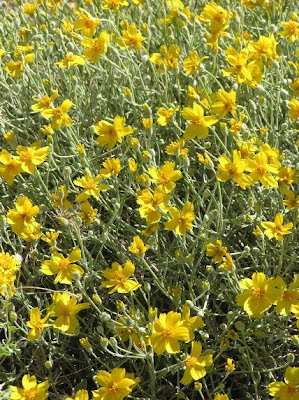 On the trip home we saw yet more colorful desert flowers.
On the trip home we saw yet more colorful desert flowers.One of the two longest days of driving was our marathon journey home from Las Vegas to Boise, with lots of birding stops along the way!
As we drove northward through Nevada toward home we went over a fairly high-elevation area. We got out of the car to look at the Juniper trees and geology and when I turned to look back at the car there was a Lazuli Bunting sitting right on the car's rear-view mirror! Though I didn't get a photo of it sitting on the car, it didn't fly far. Here it is on a road sign.
I saw 163 species of birds on this vacation, in four states. Thirty-nine of them were Life Birds for me and I list the Lifers here in the order I encountered them:
Gambel's Quail
Great-tailed Grackle
Lesser Nighthawk
Mexican Jay
Magnificent Hummingbird
Broad-billed Hummingbird
Hepatic Tanager
Flame-colored Tanager
Bridled Titmouse
Painted Redstart
Rufous-crowned Sparrow
Elf Owl
White-winged Dove
Hooded Oriole
Arizona "Strickland's" Woodpecker
Blue Grosbeak
Verdin
Northern Beardless-Tyrannulet
Gila Woodpecker
Curve-billed Thrasher
Phainopepla
Thick-billed Kingbird
Cassin's Kingbird
Gray Hawk
Canyon Towhee
Violet-crowned Hummingbird
Abert's Towhee
Dusky-capped Flycatcher
Costa's Hummingbird
Vermilion Flycatcher
Chihuahuan Raven
Varied Bunting
Whiskered Screech-Owl
Black Phoebe
Greater Roadrunner
Cactus Wren
Pyrrhuloxia
Black-tailed Gnatcatcher
Harris's Hawk
The entire list of 163 birds seen, with the photos arranged in a slideshow, can be seen at http://cyndiandjonathan.shutterfly.com/.Great-tailed Grackle
Lesser Nighthawk
Mexican Jay
Magnificent Hummingbird
Broad-billed Hummingbird
Hepatic Tanager
Flame-colored Tanager
Bridled Titmouse
Painted Redstart
Rufous-crowned Sparrow
Elf Owl
White-winged Dove
Hooded Oriole
Arizona "Strickland's" Woodpecker
Blue Grosbeak
Verdin
Northern Beardless-Tyrannulet
Gila Woodpecker
Curve-billed Thrasher
Phainopepla
Thick-billed Kingbird
Cassin's Kingbird
Gray Hawk
Canyon Towhee
Violet-crowned Hummingbird
Abert's Towhee
Dusky-capped Flycatcher
Costa's Hummingbird
Vermilion Flycatcher
Chihuahuan Raven
Varied Bunting
Whiskered Screech-Owl
Black Phoebe
Greater Roadrunner
Cactus Wren
Pyrrhuloxia
Black-tailed Gnatcatcher
Harris's Hawk
Because this blog shows off all my photos I'm never seen, so I thought I'd share this picture Cyndi took of me in Arizona.









